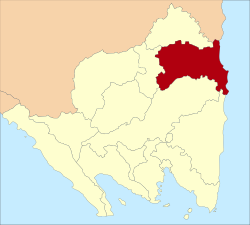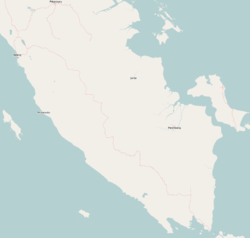|
Tulang Bawang Regency
Tulang Bawang Regency is a regency (kabupaten) of Lampung Province, Sumatra, Indonesia. The regency was created on 3 January 1997 from the eastern half of North Lampung Regency; when created, it originally covered a much wider area, but on 29 October 2008 the seven northern districts were separated off to form a new Mesuji Regency, and the eight western districts were also separated off to form a new West Tulang Bawang Regency. It now has an area of 3,466.32 square kilometres (1,338.35 sq mi) and had a population of 397,906 at the 2010 Census[2] and 430,021 at the 2020 Census;[3] the official estimate as at mid 2023 was 433,570.[1] The regency seat is the town of Menggala, located about 120 kilometres (75 mi) from the provincial capital of Bandar Lampung. The regency takes its name from the Tulang Bawang River which flows through the province. Administrative districtsThe Regency comprises fifteen districts (kecamatan) which are listed below with their areas and their populations at the 2010 Census[2] and the 2020 Census,[3] together with the official estimates as at mid 2023.[1] The table also includes the locations of the district administrative centres, the number of administrative villages in each district (a total of 147 rural desa and 4 urban kelurahan - the latter all in Menggala District), and its post code.
History Early Islamization of Lampung from the 13th century from Pasai is evidenced by the tombstone of Malik Al Saleh written in 1297 and the Batu Brak Site at Hanibung in 688 Hijriyah. Islam was brought by the four sons of Sultan Ratu Ngegalang Paksi. The arrival of the four pious people is a setback from the Sekala Brak kuno with the last king, queen sekekhummong (Sekerummong), the Buay Tumi tribe, who is Hindu Birawa and animist. This momentum is at the same time a milestone in the establishment of Kepaksian Paksi Pak Sekala Brak or Kepaksian Sekala Brak which is based on Islamic religious values. The four sons of Umpu Ratu Ngegalang Paksi are Sultan Ratu Buay Pernong, Umpu Nyerupa, Umpu Belunguh, Umpu Bejalan Diway. The spread of Islam throughout the land of Lampung from the 15th century started from West Lampung Regency. In 1525 Islam also entered through Labuhan Maringgai from Banten and Palembang. The entry of Islam in Tulang Bawang since the 16th century from the village of Pagar the god of the Penggala Tulang Bawang area was brought Islamic traders.[4] The spread of the Lampung tribe began in the 13th century AD following the marriage of the only daughter Queen sekekhummong, namely Sindi La Lalula in Islam, with the descendants of Kepaksian Pernong who settled in Batu Brak, together with Putri Indar Wati (Sibulan), who opened a new village in the area of Tulang Bawang Regency.[5] Tulang Bawang Regency was inaugurated by the Minister of Home Affairs on 20 March 1997, as a follow-up to Law no. 2 of 1997 which had provided for the establishment of both the Tulang Bawang Regency and the Tanggamus Regency.[6] EconomyMajor crops include rice, orange (a growing sector), corn, cassava, soy bean and zallaca palm fruit. As of 2010, the area under plantation in the regency is 298.943 hectares (738.70 acres), mainly rubber, coconut, oil palm and sugar cane.[7] It is particularly known though for its shrimp industry.[7] References
|
|||||||||||||||||||||||||||||||||||||||||||||||||||||||||||||||||||||||||||||||||||||||||||||||||||||||||||||||||||||||||||||||||||||||||||||||||||||||||||||||||||||||||||||||||||||||||||||||||||||||||||





